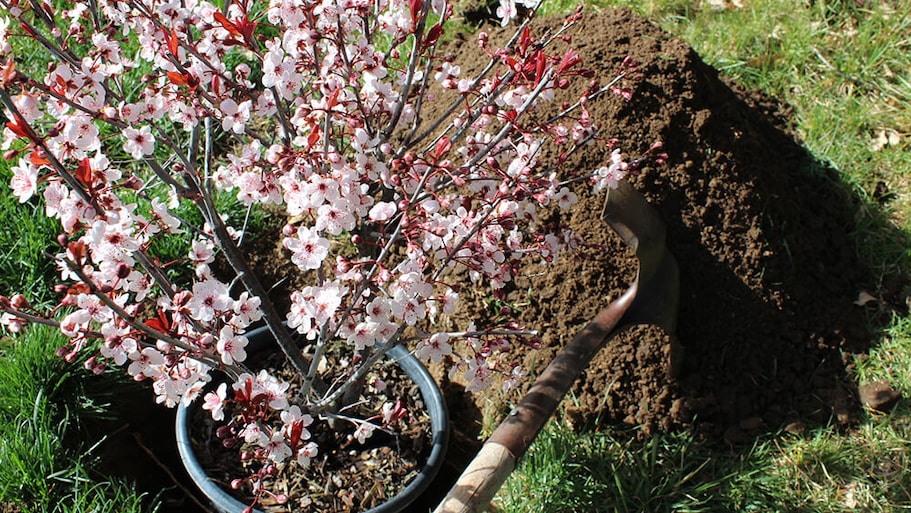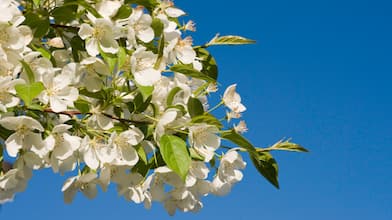Cherry blossom trees bring delicate and fragrant white to pink blossoms to your garden each spring and, once established, require minimal care
Symbols of friendship and renewal, cherry blossom trees bloom for just a few weeks each spring before producing small berries beloved by birds and wildlife. In fall, their leaves provide a riot of autumnal color.
While these ornamental trees need a fair bit of attention in their first year, once they're established, they require very little care. They can also live for up to 40 years, and like other trees, increase the value of your property, so learning how to grow a cherry blossom tree can be rewarding work.
1. Choose the Right Planting Conditions
While cherry blossom trees aren't terribly fussy, you'll get the most blossom and the healthiest, sturdiest trees if you give them close to optimal conditions, starting with the soil.
Ornamental cherries will happily grow in all soil types, from clay to sandy. The only requirement is that the soil has good drainage, as they will not grow in excessively wet or boggy conditions. Instead, the roots will quickly rot away, killing the tree.
Like all trees, these ornamentals also need nutrient-rich soil to grow and thrive, but they grow equally happily in acidic, alkaline, or neutral conditions.
2. Give the Trees Enough Light and Space
Cherry blossom trees can grow up to 40 feet tall, so they'll naturally have wide, deep root systems to anchor them in place and deliver all the nutrients they need. To reduce competition and to get the best from your cherry tree and surrounding plants, plant the tree around 20 feet from other flora.
Cherry blossoms can survive in partial shade, but to flourish, they need plenty of direct, unfiltered sunshine. Ideally, plant the tree where it can bask in full sun for at least 6 hours per day.
3. Get the Planting Right
To give it the best start in life, you need to get your tree's planting hole right. Dig it deep and wide—wide enough to spread out the root ball fully, with a bit of extra room for it to grow, too. Then give the tree an extra boost of nutrition to kick start its new life by adding a thick layer of well-rotted organic matter like manure or compost to the bottom of the hole.
Now gently situate your tree, teasing out the roots to spread across the bottom of the hole. Aim to plant it at the same depth as it was originally planted. Take a look at the trunk: You should be able to see a line just above the root ball that indicates prior planting depth. You might have to adjust the depth of the hole by adding or removing some soil.
Once you're happy with the depth, fill the hole with a mix of the soil you removed and some good quality compost or organic matter so the young tree has plenty of available nutrients to fall back on as it starts to establish itself. After all, growing roots and new branches is hungry work when you grow up to 2 feet per year.

4. Use Stakes and Ties in the First Year
For the first year or two, your new tree is trying to grow deep roots to anchor itself, so it's essentially just sitting loose in the soil. Therefore, it's a good idea to drive in a rigid tree stake and use flexible tree ties to help the tree stand firm against wind and storms. Once it anchors itself with its root system, you can remove the stake and ties.
5. Give Cherry Blossoms Extra Care During the First Year
During the first year, your new cherry needs a little extra TLC. Water it right after planting and stick to a regular watering schedule, providing deep, consistent watering once a week for at least the first year. Just remember not to water if the ground is already wet, as these trees do not like having their roots too wet for too long.
Add slow-release ornamental fruit tree fertilizer spikes around the base of the tree to slowly release nutrients for the growing roots to use. Then cover with bark chips to insulate the soil and protect the delicate roots from temperature changes.
6. Provide Ongoing Care
In their second or third year, cherry blossom trees should be well-established so you can stop the helicopter parenting. Now you can move on to a light schedule of regular tree maintenance. You shouldn't need to water at all, apart from during prolonged dry spells. It's a good idea to keep feeding though, but only once a year. The easiest way is to add fertilizer spikes in early spring, just as the tree wakes up from its winter dormancy.
7. Consult a Professional
While ornamental cherry trees are reasonably easy to grow, if you're unsure which variety to choose or how best to amend your soil to give it the best start, a local arborist can help. If you're worried your tree has an infestation or a disease, but you don't know how to handle it, arborists can deal with that, too. You can also hire a local tree maintenance specialist to take care of all your trees for you.





